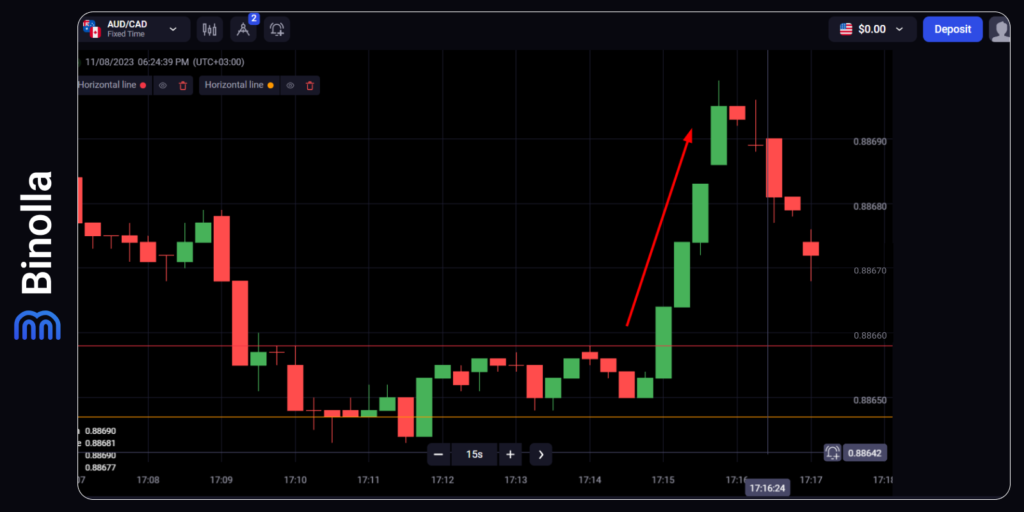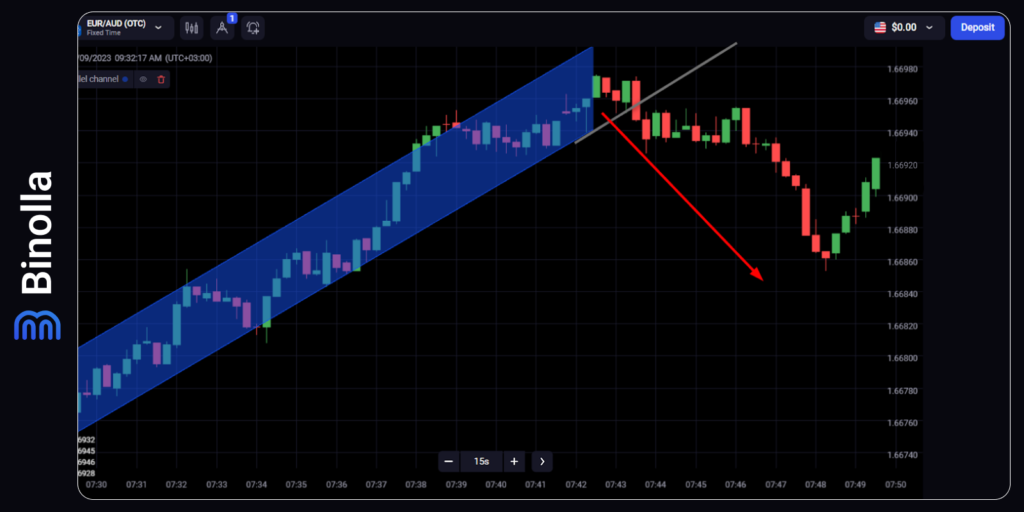Breakout Strategies in Trading: How to Benefit from Price Breakouts

Breakouts are among traders’ favorite trading signals, as they sometimes lead to huge one-sided price movements. They can be applied to all the existing trading instruments, regardless of your choice, be it Forex, stocks, digital options or other derivatives. Finding breakouts is what many traders are aimed at, but without having specific strategies, the chances are close to zero. By reading this article, you will learn more about breakout strategies of different types. Employ them and start trading on the Binolla platform.
Contents
Breakout Strategy Basics
What is a breakout strategy? As it comes from its name, this type of strategy refers to situations when the price breaks a particular level, be it support, resistance, trendline, moving average, etc. It is believed that breakouts are capable of leading to massive directional price movements, and, as statistics show, it is true.

The image above illustrates how it works. The price tests the resistance level for a while, and once it makes a breakout, a serious upward movement occurs. If you buy a Higher contract or buy a currency pair or a stock, you could profit from this simple situation.
Digital Options Breakout Strategies
Digital options traders often use breakout strategies of different types to buy Higher or Lower contracts. Moreover, sometimes they don’t even need to wait for confirmations, as they can join the movement and set a shorter expiration in order to profit from it.
There is one more important thing for digital options traders to keep in mind. They don’t need to set their goal either. The contract will be closed and calculated automatically once the expiration time comes.
Digital options traders have an advantage when trading breakouts, as they can benefit from even small but fast price movements without waiting for a new trend to expand.
Types of Breakout Strategies
There are plenty of breakout strategies that can be applied by traders. All of them depend mainly on the analysis tools that traders use to find signals. Find the most popular below.
Opening Range Breakout Strategies

One of the most popular breakout strategies is one that opens a range. In this particular case, we can see that the price fluctuates between the support and resistance levels for a while and then breaks the resistance, which is a strong buy signal.
Digital options traders can buy a Higher contract in this case, with an expiration time that depends on a particular timeframe. Forex and stock traders can buy assets to profit from this situation. They can place stop losses below the resistance level at a distance that they find appropriate for their money and risk management strategies.
As for the goals, they can use opposite signals to leave the trade or add indicators like Parabolic SAR.

Another example of an opening range breakout strategy demonstrates the price breaking through the support level. In this case, we have a clear short signal once the breakout is confirmed.
For digital options traders, this situation is a chance to buy a Lower contract. They can do it once the first candlestick closes entirely below the support line. Keep in mind that if you do it earlier, you risk having losses.
Forex and stock traders, in turn, can sell assets once the price closes below the support line and place protection orders above it. As for targets, you can simply wait for a reversal signal that may predict the end of the downtrend. Also, you can apply Parabolic SAR and close your trades once it shows you an opposite signal.
Volatility Breakout Strategies

There are plenty of volatility breakout strategies that use various indicators. We are going to provide you with one that involves the Keltner Channel indicator. This technical analysis tool is mostly used to define trends, but it is also good for measuring volatility.
Briefly, if the indicator is flat and the range is small, the volatility is believed to be modest. However, once the indicator’s lines expand and it chooses a particular direction, then you can expect a trend to appear and volatility to grow.
In this particular case, we can see that the price breaks the lower line of the Keltner Channels indicator, which means that the downtrend is gaining strength and volatility is increasing.
Digital options traders can buy a Lower contract, while Forex and stock traders can go short. The latter can also use stop losses to protect their positions. It would be a good idea to place it right above the lower line of the indicator at a distance that you think is enough to properly manage your risks.

The same volatility breakout strategy can be applied to the situation when the price goes above the upper line. Once this happens, digital options traders have an opportunity to buy Higher options, while FX and stock traders can go long. Stop losses should be placed below the upper band of the Keltner Channels indicator. Keep in mind that you can stay in the market for as long as the price is above the envelope.
A Channel Breakout Strategy
The approach that was described in the previous paragraph can be applied to these strategies as well. Keltner Channels is a classic channel indicator, which means that you can use the very same strategy here. However, we are going to show you another way to apply this method.

The image above shows a classic upside channel where the price stays for a while. You can earn money while trading in it, but at some point, the price leaves the channel, and this is another opportunity for you to engage in trading.
The moment when the support line of the price channel is broken provides you with a short signal. Digital options traders can buy a Lower contract, while FX and stock traders can go short. The stop loss can be placed above the channel’s lower band.
A Trendline Breakout Strategy

The next one involves trendlines to receive a trading signal. The price stays below the descending trendline for a while, which allows you to benefit from the downtrend. However, at some point, it breaks the trendline, and a long signal appears. This is where you can buy a Higher contract or purchase a currency pair/stock.
Some Breakout Strategy Recommendations
Find some useful breakout strategy tips below:
- Identifying the root cause of the breakout is crucial in determining the appropriate response. For example, if the breakout is driven by a fundamental shift in the market, such as a significant news event or earnings report, traders may need to adjust their trading strategies and risk management techniques accordingly. On the other hand, if the breakout is purely technical in nature, traders may focus on using technical analysis tools to capitalize on the price movement;
- Targeted trading strategies are essential for effectively capitalizing on breakouts. Trend following strategies involve identifying and riding the momentum of a breakout, while momentum trading involves entering positions based on the strength of price movements. By understanding the type of breakout, traders can select the most appropriate strategy to maximize their potential returns;
- Utilizing stop-loss orders is crucial for managing risk when trading breakouts. Stop-loss orders help protect against potential reversals and limit potential losses if the trade does not go as expected. This risk management tool is essential for preserving capital and maintaining a disciplined approach to trading breakouts;
- Using a combination of technical indicators can help confirm the validity of a breakout before entering a trade. For example, moving averages can help identify the direction of the trend, while Bollinger Bands can help gauge the volatility and potential strength of a breakout. By using multiple indicators, traders can increase their confidence in the breakout signal;
- Patience is key when trading breakouts, as false breakouts can lead to losses. Waiting for confirmation of the breakout before entering a trade can help avoid entering premature positions that may result in losses. By exercising patience, traders can increase the likelihood of entering successful breakout trades;
- Considering overall market conditions and potential catalysts that could drive a breakout is important for understanding the broader context of the trade. Economic data releases, geopolitical events, or market sentiment can all impact the likelihood and strength of a breakout. By staying informed about these factors, traders can make more informed decisions when trading breakouts;
- Staying disciplined and sticking to a trading plan is essential for executing breakout strategies successfully. Emotional decision-making can lead to impulsive actions that may result in losses. By maintaining discipline and following a well-defined trading plan, traders can avoid making irrational decisions and stay focused on their long-term trading goals;
- Monitoring volume and price action surrounding the breakout is important for gauging the strength of the move and potential follow-through. Strong volume and decisive price action can indicate a more robust breakout, while weak volume and choppy price action may suggest a lack of conviction in the move;
- Scaling into positions gradually after a breakout can help manage risk and capture potential upside momentum. By entering smaller initial positions and adding to them as the breakout develops in the desired direction, traders can minimize initial risk while potentially maximizing profits if the breakout continues to gain momentum;
- Continuously reviewing and adapting breakout strategies based on market conditions and performance is essential for improving trading outcomes over time. Markets are dynamic and constantly evolving, so it’s important for traders to regularly assess their strategies and make adjustments as needed to remain competitive and successful in their trading endeavors.
FAQ

What is a breakout strategy?
A breakout strategy is a trading method that involves identifying and entering a market when the price moves beyond a certain level of resistance or support, indicating a change in trend or momentum.
What are the benefits of using a breakout strategy?
A breakout strategy can help traders capture large price movements and avoid false signals or whipsaws that often occur in range-bound markets. A breakout strategy can also help traders set clear entry and exit points, as well as risk-reward ratios.
What are the challenges of using a breakout strategy?
A breakout strategy can be challenging to implement because it requires patience, discipline, and accurate timing. Traders need to wait for a confirmed breakout, which may not happen frequently or may be followed by a reversal. Traders also need to manage their emotions and avoid chasing the market or exiting too early or too late.
How can traders improve their breakout strategy?
Traders can improve their breakout strategy by using multiple indicators, such as volume, momentum, trend lines, moving averages, or chart patterns, to confirm the validity and strength of a breakout. Traders can also use different time frames, such as daily, weekly, or monthly charts, to identify long-term breakouts and filter out noise. Traders can also backtest their strategy on historical data and adjust their parameters accordingly.







